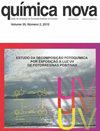铋锑膜电极溶出伏安法测定泰国米酒中痕量镉和铅
IF 0.7
4区 化学
Q4 CHEMISTRY, MULTIDISCIPLINARY
引用次数: 0
摘要
提出了溶出法测定地方黄酒饮料中痕量镉和铅的方法。采用铋-锑膜电极(Bi-SbFE),在样品溶液中直接加入4 mg L-1的铋和1 mg L-1的锑,并在AgCl /AgCl参比电极上施加-1.1 V的固定电位300 s,同时在玻碳电极上沉积铋、锑和痕量镉、铅靶金属,进行痕量金属的累积富集。采用湿酸消解法优化样品矿化预处理参数。在最佳条件下,获得了Cd和Pb在20 ~ 200µg L-1范围内的线性校准图,检出限分别为0.22和0.62µg L-1,定量限分别为0.73和2.07µg L-1。50µg L-1 Cd和Pb 7个重复分析的重复性值分别为3.6和3.3%。该方法成功地测定了泰国米酒样品中的Cd和Pb,并通过火焰原子吸收光谱法对结果进行了验证。大部分样品未受Cd和Pb污染。只有一份黄酒样本的镉污染物含量仍低于酒中镉的最高允许值。本文章由计算机程序翻译,如有差异,请以英文原文为准。
BISMUTH-ANTIMONY FILM ELECTRODE FOR STRIPPING VOLTAMMETRIC DETERMINATION OF TRACE CADMIUM AND LEAD IN THAI RICE WINE
Stripping analysis was proposed for the voltammetric determination of trace cadmium and lead in local rice wine alcoholic beverages. A bismuth-antimony film electrode (Bi-SbFE) was employed for accumulative preconcentration of trace metals by adding 4 mg L-1 of bismuth and 1 mg L-1 of antimony directly to the sample solution and simultaneously depositing bismuth, antimony, and trace cadmium and lead target metals on the glassy carbon electrode by applying a fixed potential of –1.1 V versus the Ag/AgCl reference electrode for 300 s. Pre-treatment parameters for mineralization of the sample were optimized using the wet acid digestion procedure. Under the optimum conditions, linear calibration graphs ranging 20-200 µg L-1 for Cd and Pb were obtained with detection limits of 0.22 and 0.62 µg L-1 and limits of quantitation 0.73 and 2.07 µg L-1, respectively. Reproducibility values for seven replicate analyses of 50 µg L-1 Cd and Pb were 3.6 and 3.3%, respectively. The developed method was successful for Cd and Pb analyses in Thai rice wine samples and results were validated by the flame atomic absorption spectrometric method. Most samples were not contaminated with Cd and Pb. The amount of Cd contaminants in only one of rice wine sample was still lower than the maximum permitted level of Cd in wine.
求助全文
通过发布文献求助,成功后即可免费获取论文全文。
去求助
来源期刊

Quimica Nova
化学-化学综合
CiteScore
1.60
自引率
12.50%
发文量
72
审稿时长
2-4 weeks
期刊介绍:
Química Nova publishes in portuguese, spanish and english, original research articles, revisions, technical notes and articles about education in chemistry. All the manuscripts submitted to QN are evaluated by, at least, two reviewers (from Brazil and abroad) of recognized expertise in the field of chemistry involved in the manuscript. The Editorial Council can be eventually asked to review manuscripts. Editors are responsible for the final edition of QN.
 求助内容:
求助内容: 应助结果提醒方式:
应助结果提醒方式:


